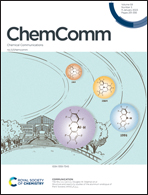MOF-derived multicomponent Fe2P–Co2P–Ni2P hollow architectures for efficient hydrogen evolution†
Abstract
In this work, we introduce Fe and Ni into Co-MOF to construct a kind of multicomponent phosphide hollow architecture with walls assembled by nanosheets. The multicomponent nature can enhance the intrinsic catalytic activity, while the sheet-like surface and inter-sheet voids provide a large active area, which is beneficial for electrolyte penetration and gas generation. As expected, the optimized product has catalytic hydrogen evolution reaction (HER) overpotentials of 105 and 161 mV at current densities of 10 and 100 mA cm−2, respectively, and maintained long-term stability for over 100 hours at 10 mA cm−2 current densities.



 Please wait while we load your content...
Please wait while we load your content...